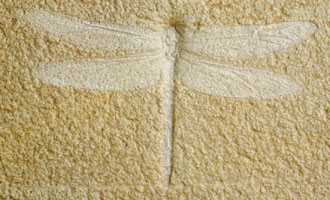Libellulium longilatum (formerly known as Cymatophlebia) is a 150 million year old dragonfly known from the Solnhofen fossil beds of Germany. Libellulium is recognized by its large, powerful wings. Dragonflies first appeared about 250 million years ago during the Early Permain Period. Since then, they have changed little, making them one of the oldest and most successful living groups of insects.
Along with damselflies, dragonflies are insects that belong to the Order Odonata. Odonatans have small antennae, long-slender abdomens, and large membranous wings. Unlike most other types of insects, dragonflies cannot fold their wings against their bodies. The large compound eyes are the main sensory organ of dragonflies. Each eye is made up of nearly 28,000 individual elements. The six legs, while not useful for walking, are very effective for capturing prey and perching. Adult dragonflies are apt fliers, preying on a variety of insects. Dragonflies spend the larval portion of their lives in freshwater.
The original fossil specimen was found in the Solnhofen Plattenkalk of southern Germany. The Solnhofen beds have long been mined for their fine grained limestone which is perfect for lithographic printing. These Late Jurassic beds are also renowned for producing marine and terrestrial animal and plant fossils of exceptional preservation. During the Late Jurassic, the Bavarian region of Germany was a series of islands and coastal lagoons. Any creature's remains that were washed into one of these lagoons would lay undisturbed and unscavanged. Layers of fine marine sediments would cover the remains, leading to nearly flawless preservation.
Libellulium longilatum 
Quantity in Basket: None
Code: ART-800
Price: $110.00
Shipping Weight: 1.20 pounds
Time: Early Tithonian of the Late Jurassic, approximately 150 million years ago.
Location: Solnhofen Plattenkalk, Bavaria, Germany.
Dimensions: 12-5/8" x 7-1/4" x 3/4"